Making staghorn sumac bread.

In most of North America, the first clusters are ready to be plucked sometime in July, with the prime time being in early August. Taste each cluster as you harvest to assure yourself that you are collecting something with flavor since occasionally they are bland. A dark purple coloration usually indicates that the flavor of the fruit has developed fully; yet some of the best clusters I’ve tasted were light pink. Sometimes a white, sticky substance coats the berry heads; this is pure essence of sumac flavor-don’t let it scare you off. I pluck about six to eight average-sized clusters for a pitcher of sumac-ade. Staghorn Sumac, poisonous sumac, however if you just look at the berry color, white is poisonous and red is good to use,survival food in the winter time, Staghorn Sumac, poisonous sumac, however if you just look at the berry color, white is poisonous and red is good to use,survival food in the winter time,Shrub or rarely small tree with open flattened crown.
Twigs thick, gray or brown with whitish bloom. Leaves pinnately compound, 30-50 cm (12-20 in) long, glabrous, usually with reddish rachis. Leaflets 11-31, lanceolate, 5-10 cm (2-4 in) long, toothed, usually turning red in early fall. Flowers numerous in a large terminal panicle, very small, whitish, blooming in early Summer. Fruits small, dark red, covered with sticky hairs,Native Americans made a flour from the seeds,rich in Vitamin C, I purifying water for the creek to make a refreshing drink.
